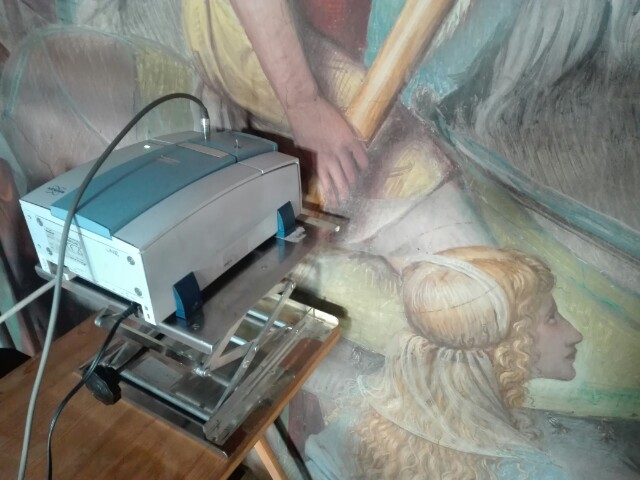User Group Leader: Francesca Piqué
www.supsi.ch/
Venue: Church of Santa Maria degli Angeli in Lugano, Switzerland
The LUINI project focused on investigating the wall painting ‘Passion and Crucifixion’ (1529) in theChurch of Santa Maria degli Angeli in Lugano. This masterpiece by Bernardino Luini (1480-1532), a pupil of Leonardo da Vinci, is the most important Renaissance wall painting in Switzerland. The painting has been the subject of several historical and artistic studies, and various restoration interventions, but it has never been studied from the technical point of view. For this purpose, in January 2017 the University of Applied Sciences and Arts of Southern Switzerland (SUPSI) started an interdisciplinary study aimed at understanding the techniques and materials used by Bernardino Luini, as well as the state of conservation of this remarkable work of art. The project combined bibliographic, historical and archival research with direct visual examination of the surface and material analysis. This latter involved a multi-technique approach mainly based on the use non-invasive techniques. Specifically, in-situ investigations performed by technical photography (UV Fluorescence, Reflected UV‐IR, UV/IR False Color) and portable X-ray fluorescence were implemented with non-invasive reflection FT-IR analysis carried out by the MOLAB team.
The MOLAB analysis campaign (9th-13th July 2018) involved the in-situ study of several areas of the extensive painted surface. The results obtained from the previous non‐invasive investigations combined with the specific indications provided by SUPSI conservators guided the selection of the analysis points.In this regard, a crucial factor was also the accessibility for the instrumentation and thus its safe arrangement in the mobile scaffolding during the measurements.A total of 58 points localized in different color areas of the wall paintingwere investigated. The presence of calcium carbonate coming from the plaster is recognizable in all the reflection FT-IR spectra acquired. Moreover, in most of these latter emerge also silicate components. These data confirm the nature of the several aggregates detected in the plaster during the analysis of the painting stratigraphy performed on cross-sections by both optical and electronic scanning microscopy (SEM-EDS). The results obtained from the non-invasive MOLAB investigations allowed a deeper understanding of the Luini’s palette. The reflection FT-IR spectra collected, indeed, provide the molecular composition of copper-based carbonates as azurite and malachite in blue and green areas respectively. This identification is in accordance with the elemental composition results obtained by XRF analysis. Interestingly, on the blue portions of the background behind the figure of St. Rocco the FT-IR investigations showed the presence of natural ultramarine (lapislazzuli). The spectral profiles acquired, in fact, show the marker band correlated to the carbon dioxide encapsulated in the mineral structure of the lapislazzuli. Kaolin, instead, emerges mainly on yellow and red-brown areas suggesting the possible use of earth-based pigments. Moreover, the FT-IR investigations also revealed the presence of deterioration products on the surface such as gypsum and oxalates. The first is probably a transformation due to pollution and/or deposition product. The presence of oxalates may be related to the aging of the organic materials.
The MOLAB access provided a valuable contribution to the interdisciplinary research aimed at disclosing the specific characteristics of Luini’s painting technique. The non-invasive FT-IR investigations have effectively integrated the multispectral and elemental point analysis completing the study of the painting materials on site. This latter in combination with the results of visual examination was fundamental for developing a tailored sampling strategy. Overall, the findings obtained from this project fill the gap of knowledge about the painting materials and the technique used by Bernardino Luinipaving the way for future comparative studies with other important wall paintings realized by the same artist in Milan and Saronno.Lastly, the significant information emerged from this research will be exploited for planning a safe and sustainable strategy for the preservation of the Luini’s masterpiece in the Church of Santa Maria degliAngeli in Lugano.

